LED fat loss therapy harnesses specific light wavelengths (635nm and 880nm) to target and shrink fat cells while boosting your metabolism. You'll need an FDA-cleared device that delivers these precise wavelengths, worn for 15-20 minute sessions, 2-3 times weekly. Clean your skin thoroughly, position the device 6-12 inches away, and always wear protective eyewear during treatment. For best results, combine LED sessions with regular exercise, proper hydration, and a balanced diet. Time your workouts either right before or after treatments to maximize fat-burning potential. The science behind this innovative approach reveals why thousands are achieving remarkable results.
The Science Behind LED Fat Loss
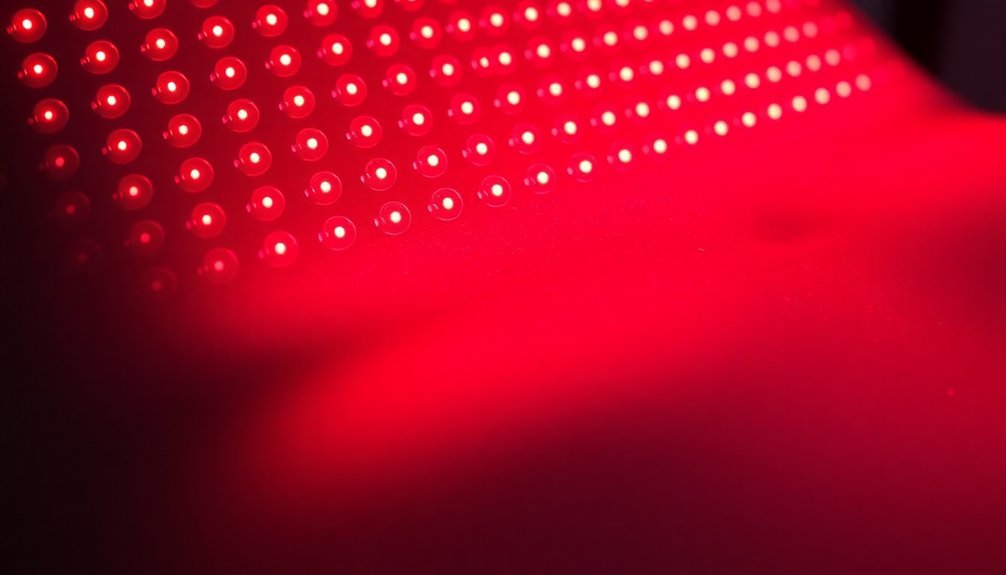
What makes LED therapy particularly effective is its impact on your lymphatic system. As the light energy enhances lymphatic drainage, your body more effectively removes the released fat content.
This scientific approach has shown impressive results, with studies demonstrating up to 444% more fat loss when combined with exercise compared to exercise alone. The treatment creates temporary micropores in fat cells that allow stored triglycerides to escape.
The treatment's effectiveness is further validated by its FDA clearance and extensive research backing.
Essential Equipment and Safety Guidelines
In accordance with safe and effective LED fat loss treatment, selecting the right equipment and following proper safety protocols are essential first steps. You'll need an FDA-cleared device that emits specific wavelengths (635nm and 880nm) and includes built-in safety features like adjustable settings and timers to prevent overexposure.
Before starting treatment, verify you're not among those who should avoid LED therapy. This includes individuals with:
- Photosensitivity or epilepsy
- Pacemakers or metal implants
- Pregnancy or nursing status
- Active cancer treatments
- Open wounds or severe skin conditions
You'll need to limit your sessions to 15-20 minutes, 2-3 times per week, and always wear protective eyewear during treatment. The red LED light penetration helps release fatty acids from cells, making them available for burning during exercise.
Keep the device properly maintained and follow manufacturer guidelines for maximum safety and effectiveness. If you have pre-existing health conditions, particularly thyroid, kidney, or liver issues, consult your healthcare provider before beginning treatment.
Remember that LED fat loss therapy works best when combined with a healthy diet and exercise routine. Regular monitoring of your progress and any potential side effects will help verify safe, long-term results.
Selecting Your LED Device
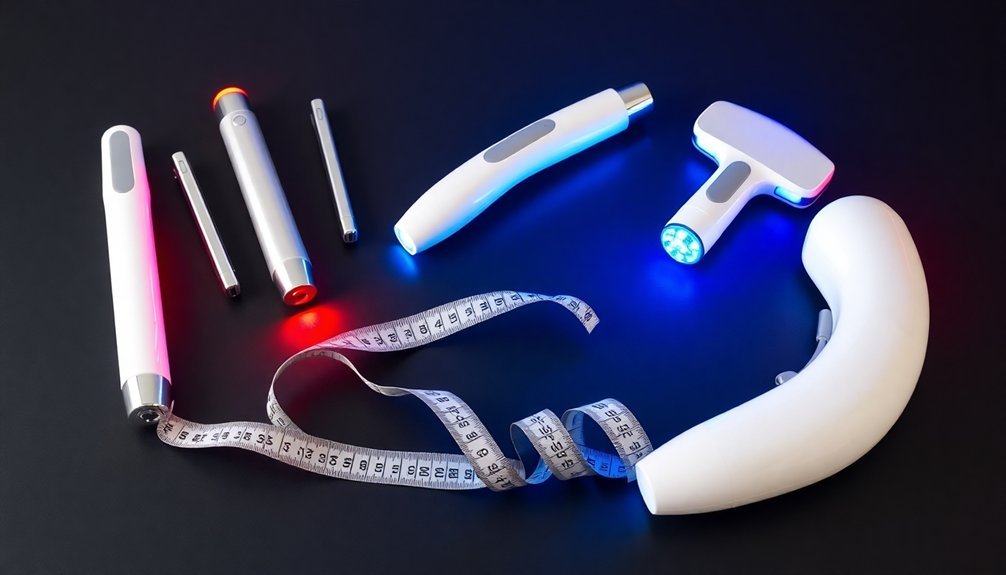
Selecting the right LED device for fat loss requires meticulous consideration of key specifications and features that directly impact treatment effectiveness. You'll want to focus on devices that combine 635nm red light with 880nm near-infrared wavelengths, as this combination has proven most effective for fat reduction. The recommended 15-20 minute sessions provide optimal exposure time for maximum fat cell response.
Consider these critical factors when comparing devices:
| Feature | What to Look For |
|---|---|
| Power Output | 25-120mW/cm² |
| LED Coverage | Multiple panels/pads |
| Safety Features | Timer, eye protection |
| Certification | FDA cleared |
When evaluating options, check that the device offers adjustable intensity settings and sufficient LED density for your treatment area. You'll benefit most from devices with proven clinical backing and extensive warranty coverage. Don't compromise on safety certifications – verify your chosen device meets FDA standards or equivalent regulatory requirements.
Look for brands with established reputations in LED therapy and strong customer support. While cost is important, prioritize value over price alone. The most effective devices typically offer versatile treatment options, including additional panels for larger areas. Remember, portability matters if you're planning to target different body zones or share the device with family members.
Optimal Treatment Areas
Numerous body areas respond effectively to LED fat loss therapy, with specific zones showing particularly promising results. You'll find the best outcomes when targeting areas closer to the skin's surface, particularly stubborn spots that haven't responded well to diet and exercise alone.
Key treatment areas for your LED therapy sessions include:
- Abdominal region – both surface fat and deeper visceral deposits
- Thighs and hips – especially effective for cellulite reduction
- Arms – targeting resistant fat deposits
- Love handles and waist area – for improved body contouring
- Back and shoulder regions – focusing on subcutaneous fat
You'll need to expose your skin directly to the light source, wearing no clothing in the treatment area. Plan for 15-20 minute sessions, and you'll see the best results when combining LED therapy with a healthy diet and regular exercise.
For the best possible outcomes, maintain a consistent treatment schedule over several weeks. Remember to protect your eyes with appropriate eyewear during each session, and always handle your device according to safety guidelines.
While you can target specific areas, full-body treatments can enhance overall fat loss results.
Step-By-Step Treatment Protocol
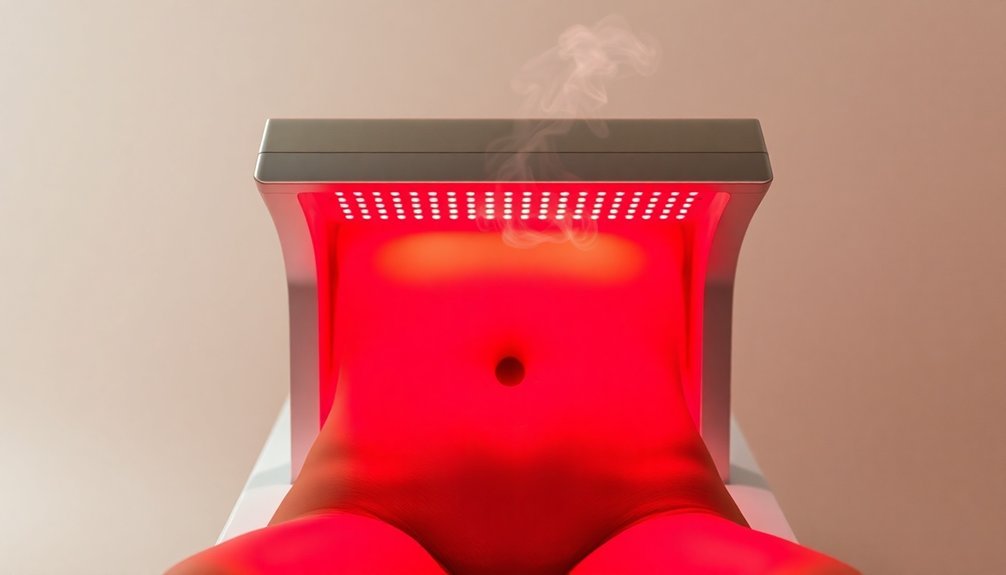
Before starting your red light therapy session, you'll need to completely clean and dry the treatment area, removing any lotions or products that could block light penetration.
Position yourself 6-12 inches from the device, ensuring your bare skin is directly exposed to the light while wearing protective eyewear.
You'll want to maintain each session for 10-20 minutes, staying as still as possible to maximize the therapy's effectiveness.
Pre-Treatment Skin Preparation
To maximize the effectiveness of LED fat loss treatments, proper preparation of your skin and body is essential. You'll need to focus primarily on hydration, as it plays a vital role in helping your body process and eliminate fat cells during treatment.
Make sure you're drinking at least a liter of water in the hour before your session, and maintain daily water intake of at least half your body weight in ounces.
For best results, follow these pre-treatment guidelines:
- Drink plenty of water before and after your session to help flush toxins and released fat from your system.
- Avoid eating for at least one hour before and after treatment to guarantee proper fat processing.
- Eliminate alcohol consumption during your treatment period, as it can cause fat cells to be reabsorbed.
- Skip any physical therapy or exercise immediately before your LED session.
- Reduce your intake of starchy carbohydrates, simple sugars, and soft drinks.
Session Timing and Positioning
Achieving best results with LED fat loss treatments comes down to proper timing and positioning during each session. You'll want to start with shorter 5-10 minute sessions, gradually increasing to 15-20 minutes over 2-3 weeks. Maintain a consistent schedule of 2-3 sessions weekly, allowing at least 6 hours between treatments on the same area.
For ideal positioning, place the device 6-12 inches from your bare skin, as clothing blocks the light's penetration. Always wear protective eyewear and verify the device covers your entire treatment area. Here's a quick reference guide for your sessions:
| Duration | Frequency | Rest Period |
|---|---|---|
| Week 1-2 | 5-10 min | 6+ hours |
| Week 3-4 | 10-15 min | 6+ hours |
| Week 5+ | 15-20 min | 6+ hours |
Remember to stay hydrated and avoid eating 1.5 hours before and after treatments. To enhance results, incorporate light exercise post-session. Track your progress through regular measurements and photos, adjusting your treatment plan as needed. Following these timing and positioning guidelines consistently will help maximize your fat loss results.
Measuring Your Progress
Successful fat loss journeys rely heavily on accurate progress tracking. When using LED treatments for fat loss, you'll want to implement multiple measurement methods to confirm you're getting reliable data about your progress.
Start by weighing yourself daily under consistent conditions, preferably first thing in the morning after using the bathroom, and calculate your weekly averages to identify true trends.
For thorough progress tracking during your LED fat loss journey, consider these essential measurement methods:
- Daily weight tracking with a reliable scale, focusing on weekly averages rather than daily fluctuations
- Body fat percentage measurements using skinfold calipers, particularly in areas where you're applying LED treatment
- Bioelectrical impedance analysis (BIA) scales for consistent body composition readings, measured at the same time daily
- Waist-to-hip ratio measurements using a measuring tape to track changes in body shape
- Progress photos taken under identical lighting and positioning to visualize changes
Combine these tracking methods to create a complete picture of your progress. Remember that each method has its margin of error, so using multiple approaches helps validate your results and keeps you motivated throughout your LED fat loss journey.
Diet and Exercise Integration
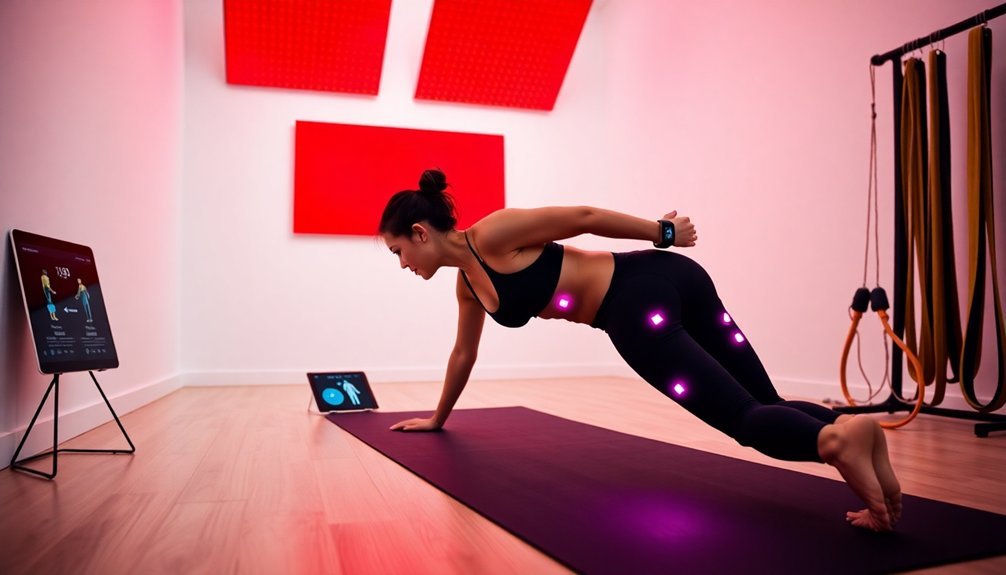
Timing your meals around your LED sessions can enhance fat loss by ensuring your body has the right nutrients for best results.
You'll want to eat a light, protein-rich meal 2-3 hours before your light therapy and schedule your workouts either right before or after your LED treatment to maximize the synergistic benefits.
Meal Timing For Results
When it comes to fat loss, dialing in your meal timing can make a meaningful difference in your results. Research shows that eating earlier in the biological day leads to greater reductions in body weight, BMI, and waist circumference.
You'll want to aim for your first meal around 9 a.m. and your last meal by 5 p.m. for ideal results.
Time-restricted eating has shown promise, with studies demonstrating modest weight changes of about 1.82% in absolute terms. To maximize your results, you'll need to combine strategic meal timing with proper exercise and nutrition fundamentals.
Key strategies to implement today:
- Establish consistent meal times to regulate your eating patterns
- Start with protein-rich foods at each meal to promote satiety
- Schedule your last meal at least 3-4 hours before bedtime
- Plan your meals around your workout schedule for best energy
- Drink 64 ounces of calorie-free beverages throughout the day
Remember that later eating can increase hunger and fat storage while decreasing fat-burning hormone levels. By aligning your meal timing with your body's natural rhythms, you'll create a more favorable environment for fat loss.
Exercise-Light Session Synergy
Building on proper meal timing, the integration of red light therapy (RLT) with exercise creates a powerful synergy for fat loss. When you combine RLT with your workout routine, you'll experience enhanced peak performance by up to 15%, compared to just 10% with exercise alone.
The therapy triggers fat cells to release triglycerides while boosting your metabolism through increased mitochondrial activity.
To maximize results, you'll want to incorporate both cardio and strength training exercises alongside your RLT sessions. This combination specifically targets adipocytes, releasing fatty acids that your body can burn for energy during workouts. The therapy also supports muscle recovery, helping you maintain consistency in your training schedule.
You'll benefit from RLT's influence on key hormones like adiponectin, leptin, and ghrelin, which help control appetite and improve insulin sensitivity. This hormonal balance makes it easier to stick to your diet while maintaining the calorie deficit needed for weight loss.
For the best results, maintain a balanced diet that provides adequate nutrients for energy and recovery, as this three-pronged approach – diet, exercise, and RLT – creates sustainable weight loss outcomes.
Common Mistakes to Avoid
Dieters often sabotage their fat loss efforts by falling into common traps that derail their progress. When combining LED therapy with your fat loss journey, you'll need to avoid these critical mistakes to achieve optimal results.
- Believing LED therapy alone will melt away fat without addressing caloric balance – you must maintain a caloric deficit through proper nutrition.
- Neglecting everyday movement and non-exercise activities, which play a vital role in your overall calorie expenditure.
- Following overly restrictive diets that eliminate entire food groups, making your journey unsustainable and likely to fail.
- Skipping resistance training, which helps preserve muscle mass and boost metabolism during fat loss.
- Expecting spot reduction from LED treatments without understanding that fat loss occurs throughout the body.
Don't fall for quick-fix promises or gimmicks that sound too good to be true. Instead, focus on combining LED therapy with proven fat loss fundamentals: maintain a reasonable caloric deficit, eat nutrient-dense foods, stay active throughout the day, and prioritize recovery.
Track your progress using reliable methods like body composition measurements and photos, rather than relying solely on the scale.
Maximizing Treatment Results
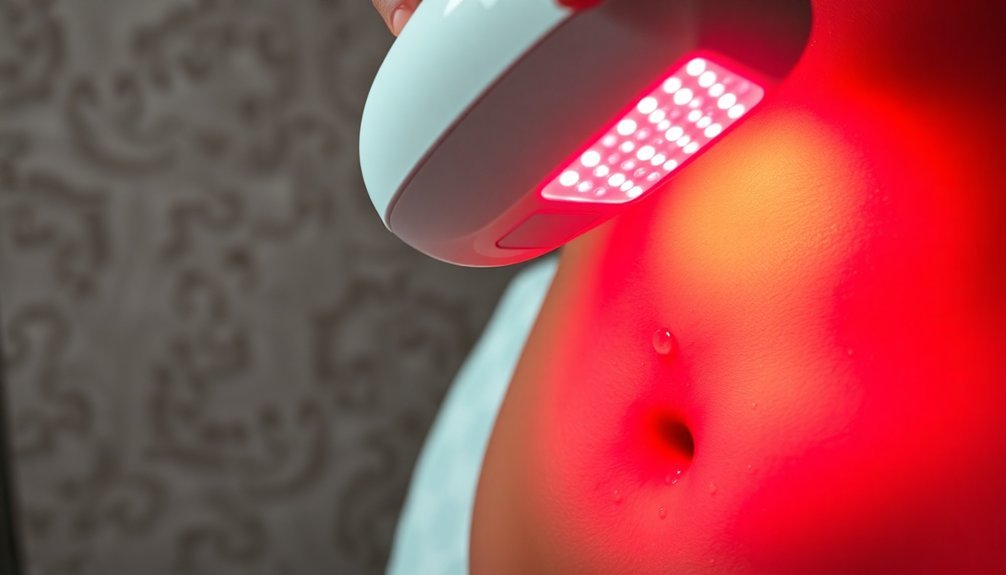
Achieving maximum results from LED fat loss therapy requires a strategic approach before, during, and after each treatment session. You'll need to focus on three key areas to enhance your outcomes: proper preparation, treatment execution, and post-session activities.
Before treatment, switch to a minimally processed diet and make certain you're maintaining a caloric deficit. Select an FDA-cleared device that combines 635nm red light with 880nm near-infrared wavelengths for the best fat release.
During your 20-30 minute sessions, you'll maximize results by maintaining consistency with three weekly treatments over four weeks.
The most vital step comes immediately after treatment. You must exercise to metabolize the released fat; otherwise, it'll simply relocate to other areas of your body.
Combine your LED therapy with regular physical activity to substantially boost fat loss compared to exercise alone. To maintain your results, you'll need to stick to a healthy lifestyle and continue periodic maintenance sessions.
The therapy works by temporarily creating pores in fat cell membranes, so you'll need to stay active to prevent fat reaccumulation. Consider tracking your leptin and ghrelin levels, as red light therapy can help regulate these hunger-controlling hormones.
Recovery Between Sessions
You'll need to allow at least 24 hours between LED fat loss sessions to guarantee proper lymphatic stabilization and ideal fatty acid processing.
During your recovery period, it's crucial to maintain regular physical activity and follow a balanced diet to support your body's natural fat-burning processes.
Your recovery timeline may vary based on your individual response to treatment and the intensity of your sessions, but you should stick to the recommended schedule of two sessions per week over four weeks for the best results.
Recovery Time Guidelines
LED light therapy offers a zero-downtime solution for fat loss, allowing you to resume normal activities immediately after each session. For best results, you'll need to space your treatments properly, with at least 6 hours between sessions targeting the same area.
Plan for 2-3 sessions weekly over a 4-week period to achieve your desired outcomes.
To maximize your recovery and results, follow these essential guidelines:
- Exercise immediately after each session to help burn the released fat through your lymphatic system
- Stay well-hydrated and maintain good circulation in treated areas
- Wear protective eyewear during every treatment session
- Keep sessions to 10-20 minutes in length
- Follow a balanced diet to support fat loss maintenance
You'll likely notice changes after just one treatment, but long-term success depends on your commitment to a healthy lifestyle. While fat won't redistribute on its own, you'll need to maintain proper nutrition and regular exercise to preserve your results.
Remember that LED therapy isn't a miracle solution – it's most effective when combined with a thorough approach to weight management, including proper diet and consistent physical activity.
Post-Treatment Body Care
Proper post-treatment care between LED sessions plays a vital role in maximizing your fat loss results.
You'll need to maintain excellent hydration by drinking plenty of water throughout the day, as this helps your lymphatic system eliminate released fat cells and toxins more effectively. Water also supports your skin's elasticity and firmness during the treatment process.
Between sessions, you should follow a sensible calorie-controlled diet and exercise routine. These lifestyle changes aren't just temporary measures – they're essential for maintaining and enhancing your results long-term. Regular physical activity will help maintain your new body shape while supporting the fat reduction process.
Keep track of your progress through scheduled follow-up appointments, where your treatment plan can be adjusted as needed. If you're combining LED therapy with other body contouring treatments, make sure to inform your healthcare provider.
For maximum safety, choose LED devices that don't attach directly to your skin, and always maintain a proper distance between the treatment panels and your body. If you experience any unusual side effects, contact your healthcare provider immediately.
Monthly maintenance sessions may be recommended to help you sustain your results.
Long-Term Maintenance Strategies
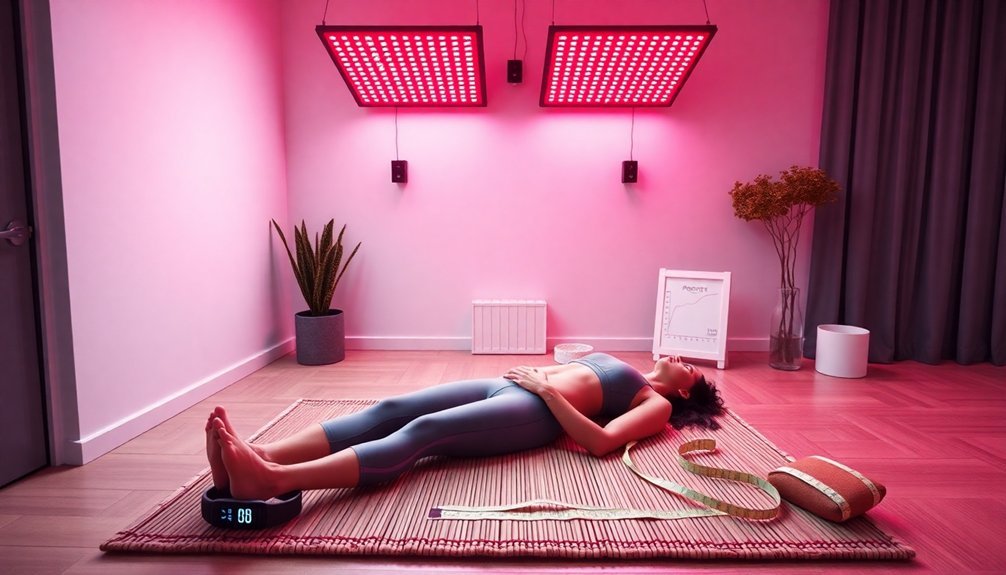
Maintaining weight loss over the long term comes down to a combination of sustainable strategies that work together. You'll need to focus on creating an energy deficit through balanced eating while avoiding fad diets that promise quick results. Combine this with about an hour of daily physical activity, mixing both cardio and strength training for best results.
To maximize your LED light therapy results and maintain your progress, incorporate these essential strategies:
- Schedule 10-20 minute LED sessions 2-3 times weekly, consistently tracking your measurements
- Practice mindful eating by paying attention to hunger cues and avoiding stress-induced snacking
- Get 7-8 hours of quality sleep each night, limiting screen time before bed
- Engage in daily movement through walking, jogging, or light weightlifting
- Monitor your progress with regular health check-ins and adjustments to your routine
Remember that successful weight maintenance isn't about extreme measures but rather sustainable lifestyle changes.
When you combine LED therapy with proper nutrition, regular exercise, stress management, and adequate sleep, you're setting yourself up for long-term success in maintaining your desired weight and body composition.
Frequently Asked Questions
Can LED Fat Loss Treatments Interfere With Prescription Medications?
While LED fat loss treatments don't typically interfere with medications, you should still tell your doctor about any treatments you're planning, as there's limited research on potential indirect interactions with prescriptions.
How Soon After Pregnancy Is It Safe to Start LED Therapy?
You should consult your healthcare provider before starting LED therapy postpartum. While it's generally safe after giving birth, your doctor can provide personalized timing recommendations based on your recovery and specific health conditions.
Does Skin Tone or Thickness Affect LED Treatment Effectiveness?
No, your skin tone and thickness don't substantially affect LED treatment effectiveness. Red and near-infrared light penetrates deeply enough to reach target tissues regardless of these factors, making it effective for all skin types.
Can LED Therapy Help Reduce Cellulite Appearance During Fat Loss?
Yes, you'll see reduced cellulite appearance when combining LED therapy with exercise, as it stimulates collagen production and improves circulation. However, you'll get better results using it alongside other treatments like radiofrequency.
Are Results Permanent if You Stop Treatments After Reaching Goals?
No, your results won't be permanent if you stop treatments. You'll need ongoing maintenance sessions and must maintain a healthy lifestyle with proper diet and exercise to prevent fat cells from refilling.
In Summary
LED fat loss treatments can work effectively when you're following proper protocols and safety guidelines. You'll see the best results by maintaining consistency, combining treatments with a healthy lifestyle, and avoiding common pitfalls. Remember to give your body adequate recovery time between sessions and track your progress. While DIY LED treatments aren't a miracle solution, they're a valuable tool in your fat loss journey when used correctly.





Leave a Reply